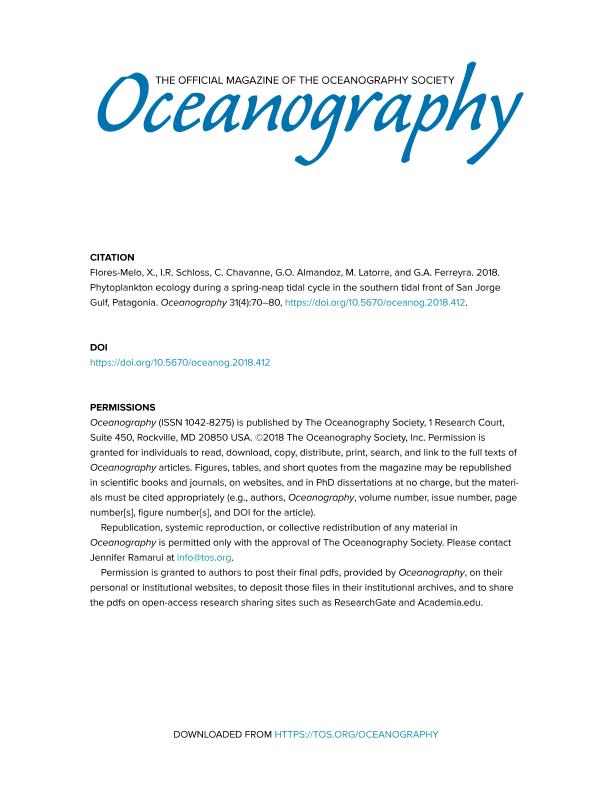Artículo
Phytoplankton ecology during a spring-neap tidal cycle in the southern tidal front of san jorge gulf, patagonia
Flores Melo, Elizabeth Ximena ; Schloss, Irene Ruth
; Schloss, Irene Ruth ; Chavanne, Cédric; Almandoz, Gaston Osvaldo
; Chavanne, Cédric; Almandoz, Gaston Osvaldo ; Latorre, Maite Pilmayquen
; Latorre, Maite Pilmayquen ; Ferreyra, Gustavo Adolfo
; Ferreyra, Gustavo Adolfo
 ; Schloss, Irene Ruth
; Schloss, Irene Ruth ; Chavanne, Cédric; Almandoz, Gaston Osvaldo
; Chavanne, Cédric; Almandoz, Gaston Osvaldo ; Latorre, Maite Pilmayquen
; Latorre, Maite Pilmayquen ; Ferreyra, Gustavo Adolfo
; Ferreyra, Gustavo Adolfo
Fecha de publicación:
12/2018
Editorial:
Oceanography Society
Revista:
Oceanography
ISSN:
1042-8275
Idioma:
Inglés
Tipo de recurso:
Artículo publicado
Clasificación temática:
Resumen
Tidal fronts are interfaces that separate stratified from mixed waters. The stratified surface zone of a front has lower inorganic nutrient concentrations than the mixed side, and thus, phytoplankton assemblages are expected to differ from one side of the front to the other. Here, we characterize the physics, nutrient dynamics, and biology of the southern front in San Jorge Gulf (SJG), Argentina, during a spring-neap tidal cycle. Baroclinic instabilities influence the shape and position of the front and presumably play an important role in the horizontal transport across the front. The highest phytoplankton biomass concentrations were found in the waters of the stratified side of the front during neap tide, with picophytoplankton, cyanobacteria, and nanophyto-plankton being the main contributors to the total autotrophic biomass. Bacteria contribute the most to heterotrophic biomass. In contrast, during spring tide, the carbon contribution of microphytoplankton was higher than during neap tide. In the mixed side, cells photoacclimate to optimum light conditions, suggesting that cells near the surface, which are probably photoinhibited, and cells below the euphotic zone, which are light-limited, are quickly advected by turbulent vertical motions to depths with optimal irradiance conditions.
Palabras clave:
Argentine Sea, San Jorge Gulf
,
Frontal areas
,
Phytoplankton
,
stratification
Archivos asociados
Licencia
Identificadores
Colecciones
Articulos(CADIC)
Articulos de CENTRO AUSTRAL DE INVESTIGACIONES CIENTIFICAS
Articulos de CENTRO AUSTRAL DE INVESTIGACIONES CIENTIFICAS
Articulos(CESIMAR)
Articulos de CENTRO PARA EL ESTUDIO DE SISTEMAS MARINOS
Articulos de CENTRO PARA EL ESTUDIO DE SISTEMAS MARINOS
Citación
Flores Melo, Elizabeth Ximena; Schloss, Irene Ruth; Chavanne, Cédric; Almandoz, Gaston Osvaldo; Latorre, Maite Pilmayquen; et al.; Phytoplankton ecology during a spring-neap tidal cycle in the southern tidal front of san jorge gulf, patagonia; Oceanography Society; Oceanography; 31; 4; 12-2018; 104-112
Compartir
Altmétricas



